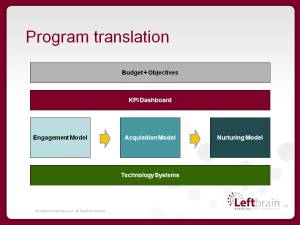Just before Thanksgiving I published the second installment in a two-part series on the “Elements of a Modern Demand Generation Plan.”
I’ve done a number of posts over time on the various holistic elements that go into successful B2B demand generation here on Propelling Brands, on the Silverpop Demand Generation blog and more recently on the Left Brain Marketing (LBM) DemandGen (r)Evolution blog.
Yet I note in this new LBM post that despite all the tips and tricks out there in guides, blog posts and Tweets, for a lot of marketers there still seems to be a ‘glaring gap’:
How do you build a modern demand generation program? What does that entail? Where do you start? What are the keys to success?
I think this is the real disconnect for many B2B marketers today. They do not really understand what it looks like to architect an entire, modern demand generation program, end-to-end – one that is appropriate for a marketing environment in which power has shifted from sellers to buyers and where Web 2.0 realities predominate. These B2B marketers need a way to sort out how all of these tactical systems and advice in blog posts and through consultants all come together in a real program.
I argue in the first post in the series that starting place should be a thoughtful and comprehensive demand generation plan. I then proceed to outline the initial research and analysis required to start with developing your plan — a first step in the process I refer to as establishing ‘buyer-targeting context.’
I then use the second post in the series to explain how you translate this initial research and analysis into actual demand generation programs — a second step in the process I refer to as ‘program translation.’
This is the same process we go through with clients of Left Brain Marketing to help them develop their own demand generation programs, so the content of these two posts is well-grounded in reality. (I also provide a number of slides right out of our decks as illustrative graphics in part two.)
I end the second post by noting:
There is certainly more to say around the details and best practices of building out your sub models and of operating and refining your demand generation program. … Nonetheless, I hope this post and the previous one represents a good starting place for wrapping your head around how to approach and build a successful demand generation plan.
And I really do believe these two posts are a good starting place — and a comprehensive reference source — for your own B2B demand generation programs.
Click here to read the full part-one post on LBM DemandGen (r)Evolution; and click here to read the full part-two post.







